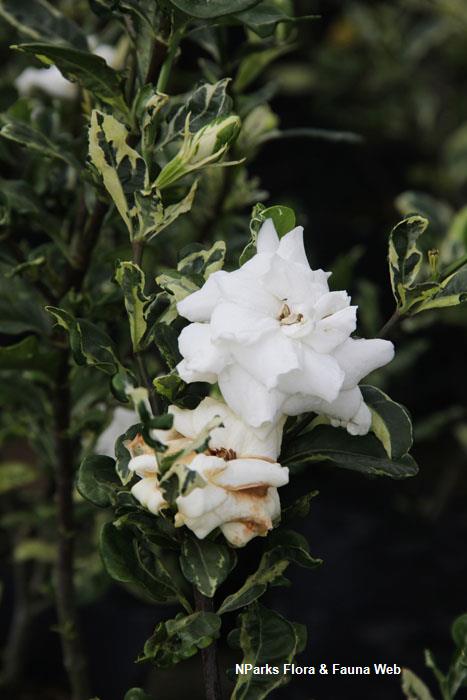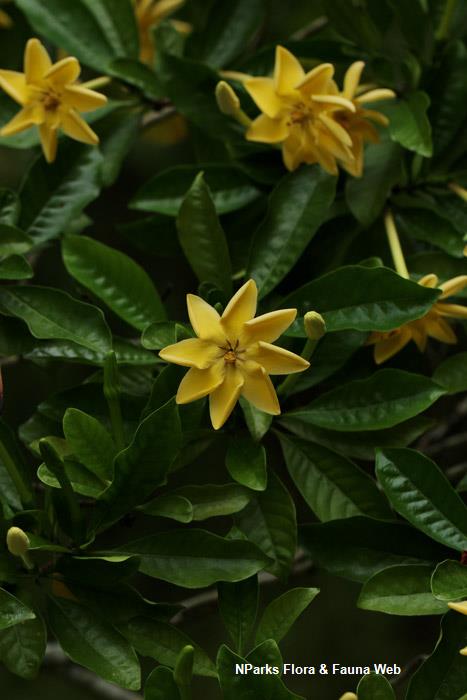
Back
Gardenia mutabilis Reinw. ex Blume
| Family Name: | Rubiaceae |
Gardenia mutabilis is a tree prized for its vibrant fragrant flowers. Fresh flowers are observed to be cream coloured and gradually turn yellow over time. Found naturally in rainforests and limestone forests, it thrives in cultivation when grown under full sunlight and fertile, well-drained soil.
Name
Classifications and Characteristics
| Plant Division | Angiosperms (Flowering Seed Plants) |
|---|---|
| Plant Growth Form | Tree |
| Lifespan (in Singapore) | Perennial |
| Mode of Nutrition | Autotrophic |
| Plant Shape | Irregular |
| Maximum Height | 5 m |
Biogeography
| Native Distribution | South Philippines to Sulawesi |
|---|---|
| Native Habitat | Terrestrial |
| Preferred Climate Zone | Tropical |
| Local Conservation Status | Non-native (Horticultural / Cultivated Only) |
Description and Ethnobotany
| Growth Form | It is a tree, up to 5 m tall. The bark is smooth to scaly and pale yellowish brown. |
|---|---|
| Foliage | Leaves are obovate to elliptic, measuring (5 –) 9 – 15 cm long and (2 –) 2.5 – 5 cm wide, and in opposite arrangement. Each leaf has 8 – 12 pairs of lateral veins. They are flat on the upper side of the leaf and prominent on the underside. The leaf tip is sharply pointed (acute) to obtuse while the base is wedged shaped (cuneate). The leaves turn characteristically dark brown to black after drying with its lateral veins submersed in the leaf blade tissue. The stipule is fused, forming a cylindrical tubular structure (about 1 – 1.5 cm long), and minutely hairy (puberulent) on the outside. The stipule is often coated with resin. The tip of the stipule is slightly 2-lobed to subtruncate or (rarely) slightly cleft on one side. The petiole is 0.7 – 1.5 cm long. |
| Flowers | Flower occurs in solitary. They are fragrant and cream to yellow coloured. Fresh flowers are observed to be cream coloured and gradually turn yellow over time. It is salver-shaped with long slender tube, reaching up to 6.5 – 7.5 cm long, and 7 – 8 lobes, measuring (2.5 - ) 2.9 – 3.2 cm long and 0.7 – 1 cm wide. The flower comprises of 7 – 8 stamens occurring between the flower lobes just below the throat. The style is glabrous and the stigma is club-like and protrudes out of the flower throat. Calyx is top-shaped (obconical) to cup-shaped (cupular) and tightly sheathing the corolla tube. The calyx margin is subtruncate. |
| Fruit | The fruit is subglobose, measuring 2.3 – 2.7 cm long and 2 – 2.5 cm wide. At maturity, the surface of the fruit become wrinkled, and it splits open irregularly, revealing many seeds which are surrounded by bright orange-red pulp. |
| Habitat | It is found in primary lowland forests and limestone forests. |
| Associated Fauna | It is pollinated by insects. |
| Taxonomy | This species was previously misidentified and misnamed in the trade as Gardenia gjellerupii. It has now been correctly identified as Gardenia mutabilis by Low Yee Wen (SING herbarium). |
| Etymology | The genus Gardenia commemorates Alexander Garden (1730 – 1791), a Scottish naturalist who contributed significantly to the flora in America. The specific epithet, in Latin, means changeable. |
Landscaping Features
| Desirable Plant Features | Ornamental Flowers, Fragrant |
|---|---|
| Landscape Uses | Parks & Gardens |
| Thematic Landscaping | Golden Garden |
Fauna, Pollination and Dispersal
| Fauna Pollination Dispersal Associated Fauna | Butterfly-Attracting |
|---|---|
| Pollination Method(s) | Biotic (Fauna) (Insects (Butterfly, Moth)) |
| Seed or Spore Dispersal | Biotic (Fauna) |
Plant Care and Propagation
| Light Preference | Full Sun |
|---|---|
| Water Preference | Moderate Water |
| Plant Growth Rate | Moderate |
| Rootzone Tolerance | Fertile Loamy Soils, Well-Drained Soils |
| Propagation Method | Seed, Stem Cutting |
Foliar
| Foliage Retention | Evergreen |
|---|---|
| Mature Foliage Colour(s) | Green |
| Mature Foliage Texture(s) | Glossy / Shiny |
| Foliar Type | Simple / Unifoliate |
| Foliar Arrangement Along Stem | Opposite |
| Foliar Shape(s) | Non-Palm Foliage (Elliptical, Obovate) |
| Foliar Margin | Entire |
| Foliar Apex - Tip | Acute, Obtuse |
| Foliar Base | Cuneate |
| Typical Foliar Area | Mesophyll ( 45cm2 - 182.25 cm2 ) |
| Leaf Area Index (LAI) for Green Plot Ratio | 4.5 (Shrub & Groundcover - Dicot) |
Non - Foliar and Storage
| Trunk Type (Non Palm) | Woody |
|---|---|
| Mature Bark Texture | Smooth, Scaly |
| Stem Type & Modification | Woody |
| Root Type | Underground |
Floral (Angiosperm)
| Flower & Plant Sexuality | Bisexual Flowers |
| Flower Colour(s) | Cream / Off-White, Orange, Yellow / Golden |
|---|---|
| Flower Grouping | Solitary |
| Flower Symmetry | Radial |
| Individual Flower Shape | Salverform |
| Flowering Period | A Few Times Yearly |
| Flowering Habit | Polycarpic |
Fruit, Seed and Spore
| Mature Fruit Texture(s) | Wrinkled |
|---|
References
| References | Wong, K.M. and Low, Y.W. (2011). A revision of Philippine Gardenia (Rubiaceae). Edinburgh Journal of Botany 68: 11-32. |
|---|
Image Repository
Others
| Master ID | 732 |
|---|---|
| Species ID | 2027 |
| Flora Disclaimer | The information in this website has been compiled from reliable sources, such as reference works on medicinal plants. It is not a substitute for medical advice or treatment and NParks does not purport to provide any medical advice. Readers should always consult his/her physician before using or consuming a plant for medicinal purposes. |















